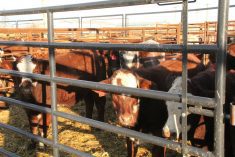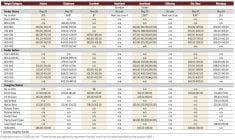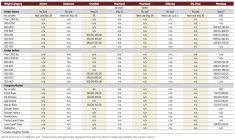Feeder cattle prices at auction yards across Manitoba were steady to slightly stronger during the week ended April 5, underpinned by a crash in U.S. grain futures.
Robin Hill, manager of Heartland Livestock Services at Virden, said prices for feeder cattle that weighed 800 pounds or less were about one to two cents per pound higher, which is “a little increase.”
On March 28, the U.S. Department of Agriculture released its first planting intentions report for the 2013-14 crop year, as well as its report on stocks as of March 1, 2013.
Read Also

Pig transport stress costs pork sector
Popular livestock trailer designs also increase pig stress during transportation, hitting at meat quality, animal welfare and farm profit, Agriculture and Agri-Food Canada researcher says
The planting intentions report was neutral for the market, but the stocks report was extremely bearish, as it showed much more of a corn supply in the U.S. than most people thought. The bearish report caused the corn market to see significant losses.
The lower grain prices brought increased demand, which supported cattle values.
Feeder cattle that were on the heavier side, weighing more than 800 lbs., managed to keep steady, with the majority of the strength linked to the downswing in U.S. corn futures as well.
Good demand from multiple areas also helped keep a firm floor under the market. Hill noted buyers from Eastern and Western Canada were in the mix, as were U.S. buyers.
The eastern market is very picky on quality, and will pay good prices for what it wants, which also helped underpin values, according to Hill.
There wasn’t a lot of local demand for grass cattle during the week, but that could start to change if it continues to look like there will be good grass production this year.
“The local interest may start picking up as the weeks progress here,” said Hill.
Even though feeder cattle prices were steady to stronger, the market still isn’t where producers in Manitoba want it to be. Prices could move higher on a certain day, but in the grand scheme of things high feed costs will continue to pressure the market.
“Very, very quiet”
There were still strong volumes at most auction yards in the province during the week, though they started to decline. Farmers are starting to become busy with other projects.
Some auction yards will change their schedules soon, if they haven’t already. For example, Heartland Livestock Services at Brandon reported it will now only hold one sale per week until fall.
Once spring seeding starts, the markets will become “very, very quiet,” because farmers will be too busy to market their cattle, said Hill.
There will be one last push of cattle before seeding starts this spring, which is expected to start later than normal because of excessive snow and below-normal temperatures.
Spring road bans in the province may slow marketing down, because some roads will be closed to heavier trucks, including those carrying cattle.
Slaughter cattle continued to come in strong numbers during the week. Prices on the slaughter side of the market were firm, underpinned by a slight increase in demand for less expensive beef choices.


















